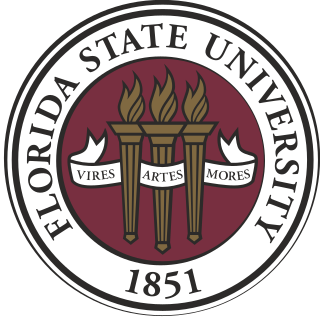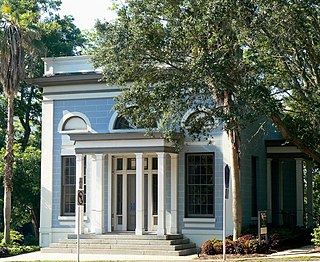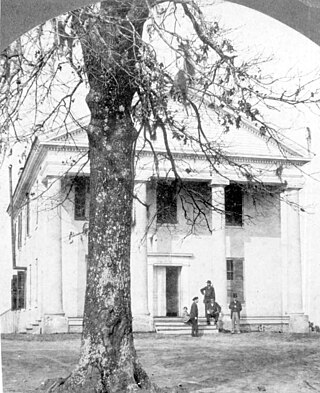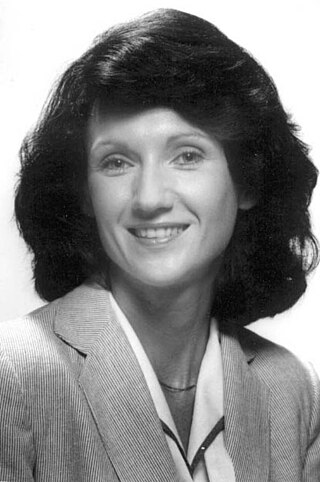
Tallahassee is the capital city of the U.S. state of Florida. It is the county seat and only incorporated municipality in Leon County. Tallahassee became the capital of Florida, then the Florida Territory, in 1824. In 2022, the population was 201,731, making it the eighth-most populous city in the state of Florida. The population of the Tallahassee metropolitan area was 390,992 as of 2022. Tallahassee is the largest city in the Florida Big Bend and Florida Panhandle region, and the main center for trade and agriculture in the Florida Big Bend and Southwest Georgia regions.

Leon County is a county in the Panhandle of the U.S. state of Florida. It was named after the Spanish explorer Juan Ponce de León. As of the 2020 census, the population was 292,198.

Quincy is a city in and the county seat of Gadsden County, Florida, United States. Quincy is part of the Tallahassee metropolitan area. The population was 7,970 as of the 2020 census.

Florida State University is a public research university in Tallahassee, Florida, United States. It is a senior member of the State University System of Florida. Chartered in 1851, it is located on Florida's oldest continuous site of higher education.

Florida Agricultural and Mechanical University (FAMU), commonly known as Florida A&M, is a public historically black land-grant university in Tallahassee, Florida. Founded in 1887, It is the third largest historically black university in the United States by enrollment and the only public historically black university in Florida. It is a member institution of the State University System of Florida, as well as one of the state's land grant universities, and is accredited to award baccalaureate, master's and doctoral degrees by the Commission on Colleges of the Southern Association of Colleges and Schools.

Tallahassee Community College (TCC) is a public community college in Tallahassee, Florida. It is part of the Florida College System and is accredited by the Southern Association of Colleges and Schools. As of fall 2017, TCC reported 24,639 students.

Thomas Kent Wetherell was an American politician and educator. He served as a member of the Florida House of Representatives from 1980 to 1992, and was president of Florida State University from 2003 through 2009.

Talbot "Sandy" D'Alemberte was an American lawyer, professor, politician, educational administrator, president of the American Bar Association, and president of Florida State University (FSU), from 1994 to 2003.
The history of Tallahassee, Florida, much like the history of Leon County, dates back to the settlement of the Americas. Beginning in the 16th century, the region was colonized by Europeans, becoming part of Spanish Florida. In 1819, the Adams–Onís Treaty ceded Spanish Florida, including modern-day Tallahassee, to the United States. Tallahassee became a city and the state capital of Florida in 1821; the American takeover led to the settlements' rapid expansion as growing numbers of cotton plantations began to spring up nearby, increasing Tallahassees' population significantly.

The Union Bank of Tallahassee, Florida was established around 1830 and the bank building constructed for it in 1841. It is Florida's oldest surviving bank building. It is located at Apalachee Parkway and Calhoun Street and is now a museum and archive and research center for African American history. On February 24, 1971, it was added to the U.S. National Register of Historic Places.

The history of Florida State University dates to the 19th century and is deeply intertwined with the history of education in the state of Florida and in the city of Tallahassee. Florida State University, known colloquially as Florida State and FSU, is one of the oldest and largest of the institutions in the State University System of Florida. It traces its origins to the West Florida Seminary, one of two state-funded seminaries the Florida Legislature voted to establish in 1851.

The Florida State University College of Fine Arts, located in Tallahassee, Florida, is one of sixteen colleges comprising the Florida State University (FSU).

The Mary Brogan Museum of Arts and Science, also known as the Brogan Museum and MOAS was an art and science museum located at 350 South Duval Street, Tallahassee, Florida.
Lincoln High School, also known as Lincoln Academy, was a high school for African Americans in Tallahassee, Florida, United States. It is commonly referred to as "Historic Lincoln High School" or "Old Lincoln". There is no connection with Leon County's current Lincoln High School other than name.

James R. Ford was an American educator, politician, and businessman. In 1972, Ford became the first African-American mayor of Tallahassee, Florida, and the first Black mayor of a U.S. state capital city. He later served for fourteen years as a city commissioner, being repeatedly re-elected.
The following is a timeline of the history of the city of Tallahassee, Florida, U.S.

Virginia Bass "Ginger" Wetherell is an American businesswoman and politician. She was a member of the Florida House of Representatives for the 2nd district between 1982 and 1988, then the first Secretary of the Florida Department of Environmental Protection from 1991-1998.


















